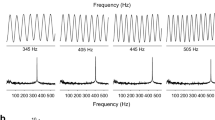Summary
-
1.
The air bubble comprising the physical gill of the Corixinae is a stimulus-conducting apparatus external to the tympanal organs, which transforms water-borne sound into airborne sound. Like all air bubbles under water, it is a system capable of oscillation and resonance; the resonant frequency depends primarily on the volume of the air bubble.
-
2.
A computer-controlled method was developed by which the resonance properties of the respiratory air bubble ofCorixa punctata could be measured in the freely moving animal under controlled acoustic conditions.
-
3.
The resonant frequencyf rof the air bubble varies with air volume V according to the relationf r∝V −2.3.
-
4.
When the air supply is replenished by taking in air at the water surface, the enlarged volume of the air bubble brings about a stepwise reduction in resonant frequency. Thereafter, the resonant frequency gradually rises as the volume slowly shrinks, until the animal again takes in air.
-
5.
In the temperature range 4 °C to 16 °C resonant frequencies between 1.35 kHz and 3.35 kHz are observed. The resonant frequency of an “average” animal at constant temperature varies owing to the change in air-bubble volume, by ±500 Hz about the mean (central) frequency. The distributions of the resonant frequencies shift toward lower frequencies as the water temperature rises. The central frequency falls about linearly from 2.4 kHz at 4 °C to 1.95 kHz at 16 °C (Figs. 6–8).
-
6.
The resonant peak of the air bubble is ca. 14 dB above the low-frequency level, as calculated from the logarithmic decrement of 0.6±0.1. As compared with spherical air bubbles, the oscillations of the respiratory air bubble are considerably more damped.
-
7.
When caused to resonate by external alternating pressures, the air bubble of the physical gill exhibits internal pressure alternation of greatest amplitude in the region of its resonant frequency. The range over which the resonant frequency varies coincides with the range of frequencies to which the mesothoracic tympanal organ is especially sensitive; the latter bandwidth is extended by the bilateral asymmetry of the sense cell A1 (Fig. 9).
-
8.
The results are discussed in relation to the sound sensitivity of the tympanal organs and the function of the physical gill in sound production.
Similar content being viewed by others
References
Bergmann L, Schäfer C (1970) Lehrbuch der Experimentalphysik, Bd I, Gobrecht H (Hrsg) Mechanik, Akustik, Wärme, de Gruyter, Berlin
Ege R (1915) On the respiratory function of the air stores carried by some aquatic insects. Z Allg Physiol 17:81–124
Exner ML (1951) Messung der Dämpfung pulsierender Luftblasen in Wasser. Acustica Akust Beih 1:25–33
Finke C (1968) Lautäußerung und Verhalten vonSigara striata undCallicorixa praeusta (Corixidae Leach, Hydrocorisae Latr.). Z Vergl Physiol 58:398–422
Finke C, Prager J (1981) An audiospectrographic study of male stridulation in the genusCorixa Geoffr. (Hemiptera, Corixidae). Z Naturforsch 36c:189–191
Hagemann J (1910) Beiträge zur Kenntnis vonCorixa. Zool Jahrb Abt Anat Ontog Tiere 30:373–426
Jansson A (1973) Stridulation and its significance in the genusCenocorixa (Hemiptera, Corixidae). Behaviour 46:1–36
Landau LD, Lifschitz EM (1970) Lehrbuch der theoretischen Physik, Bd 6, Hydrodynamik. Vieweg, Braunschweig
Lauer H (1951) Über die thermische Dämpfung von Blasen verschiedener Gase in Wasser. Acustica Akust Beih 1:12–24
Lauterborn W (1970) Resonanzkurven von Gasblasen in Flüssigkeiten. Acustica 23:73–81
Meyer E, Neumann E-G (1967) Physikalische und technische Akustik. Vieweg, Braunschweig
Meyer E, Tamm K (1939) Eigenschwingung und Dämpfung von Gasblasen in Flüssigkeiten. Akust Z 4:145–152
Michel K (1977) Feinstrukturelle Besonderheiten im mesothorakalen Tympanalorgan der RuderwanzeCallicorixa praeusta (Heteroptera: Corixidae). Entomol Germ 3(4):316–323
Minnaert M (1933) On musical air-bubbles and the sounds of running water. Philos Mag 16:235–248
Popham EJ (1960) On the respiration of aquatic Hemiptera Heteroptera with special reference to the Corixidae. Proc Zool Soc (Lond) 135:209–242
Prager J (1973) Die Hörschwelle des mesothorakalen Tympanalorgans vonCorixa punctata Ill. (Heteroptera, Corixidae). J Comp Physiol 86:55–58
Prager J (1976) Das mesothorakale Tympanalorgan vonCorixa punctata Ill. (Heteroptera, Corixidae). J Comp Physiol 110:33–50
Prager J, Larsen ON (1981) Asymmetrically hearing in the water bugCorixa punctata Ill. observed with laser vibrometry. Naturwissenschaften 68:579–580
Prager J, Streng R (1981) Schallrezeption und ihre Anpassung an die aquatile Lebensweise bei Corixiden. Mitt Dtsch Ges Allg Angew Entomol 3:239–242
Prager J, Theiß J (1982) The effect of tympanal position on sound-sensitivity of the metathoracic scolopale organ ofCorixa. J Insect Physiol 28:447–452
Rahn H, Paganelli CV (1968) Gas exchange in gas gills of diving insects. Respir Physiol 5:145–164
Skudrzyk E (1954) Die Grundlagen der Akustik. Springer, Wien
Strasberg M (1953) The pulsation frequency of nonspherical gas bubbles in liquids. J Acoust Soc Am 25:536–537
Theiß J (1981) Schallerzeugung und Stridulationsaktivität bei Corixiden. Mitt Dtsch Ges Allg Angew Entomol 3:235–238
Theiß J (1982) Generation and radiation of sound by stridulating water insects as exemplified by the corixids. Behav Ecol Sociobiol 10:225–235
Author information
Authors and Affiliations
Rights and permissions
About this article
Cite this article
Prager, J., Streng, R. The resonance properties of the physical gill ofCorixa punctata and their significance in sound reception. J. Comp. Physiol. 148, 323–335 (1982). https://doi.org/10.1007/BF00679017
Accepted:
Issue Date:
DOI: https://doi.org/10.1007/BF00679017




